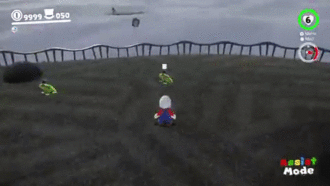Cap throw

A cap throw is one of the most basic movement mechanics in Super Mario Odyssey, and is performed by pressing X or Y. Shaking the controller in various ways can also be used to perform many different varieties of cap throws, each with a different purpose. Cap throws are used for a vast amount of actions in Super Mario Odyssey, including capturing enemies, triggering levers or scarecrows, opening doors, collecting certain items, and even using Cappy as a platform to perform a vault or cap bounce.
After performing a cap throw, it is also possible to home Cappy in to nearby objects. This is known as a homing cap throw.
Regular cap throws
Regular cap throws, or just cap throws are the most used type of cap throw. They are commonly seen in capture warps and general movement. They are the most basic type of cap throw and do not require motion controls. The biggest advantage or regular cap throws is that they are extremely useful in both cap bounces and vaults .
Spinthrows
Spinthrows are cap throws that fly in a circle around Mario. A spinthrow is performed by rotating the controller by 90 degrees in a sharp fashion, or by jerking the controller to the side. Additionally, they can be performed by spinning Mario until he is in a spinning state and pressing y/x. They are one of the most useful types of cap throw due to their speed. The speed of a spinthrow is faster than any other type of throw except triple throws, making spinthrows great substitutes for regular cap throws when performing actions such as capturing or activating levers. Spinthrow cap bounces are impossible.
Spinthrows are often seen in trickjumping when a player intends to time a triple throw by using the spinning animation of the spinthrow.
Spinthrows are also seen in multiple glitches and exploits like Rocket Flower refreshes and Chomp Through The Rocks Clip.
Spinthrow roll cancels are one of the most used roll cancels in both regular speedrunning and Koopa Freerunning.
Upthrows
Upthrows are cap throws that move above the position where Mario executed the upthrow. Upthrows are performed by sharply jolting the controller upwards. They are most often seen in capture warps, most notably Dram Strat. They are also frequently featured in roll cancels, particularly in circumstances where reducing the likelihood of unwanted interaction between cappy and the surroundings may be preferable. Upthrow cap bounces are one of the least used cap bounces in the entire game but they are seen in lost kingdom after obtaining the moon Peeking Out From Under The Bridge if the player is not in a capture.
Downthrows
Downthrows are cap throws that move along the ground. Downthrows are the most annoying capthrows to perform since they cannot be performed as easily on pro controllers. If using joycons, downthrows are performed by sharply jolting the controller downwards or groundpounding and then capthrowing after waiting a short while. On pro controllers, downthrows can only be executed using the second method.
Downthrows are one of the least used cap throws in the game but a downthrow cap bounce is very important in the minimum zl/zr presses low% category. Without them, there would have to be an extreme amount of min zl/zr re-routing.
Triple throws
A triple throw is a variation of a regular cap throw that has a higher speed. A triple throw is much like a triple jump since it is performed by chaining three cap throws. The third cap throw in the chain will be a triple throw. In the cap throw chain, the first and second cap throws can be any type of cap throw but the final cap throw must be a regular cap throw.
Double throws and triple throws cannot be performed if Mario is underwater or standing on ice (excluding shallow regions of water where Mario can stand normally, such as in areas of the Seaside Kingdom). However, cap throws performed in either of these circumstances can still act as the first throw to prepare double or triple throws.
Triple throws are most often seen in trickjumping as they allow hctts (Homing Cap Throw Twirls) to be executed more swiftly which loses less height than a normal hctt.
